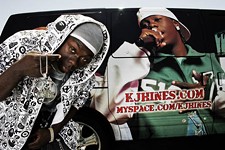Rock & Roll Books
Gift guide
By Robert Gabriel, Fri., Dec. 3, 2004
Hip: The History
by John LelandEcco/HarperCollins, 405 pp., $26.95
Standing strategically at the crossroads of America's multiracial divide, hip navigates floods of cultural mud as if dancing with style. Arriving in this "sweet land of liberty" by way of shackles and chains, the elusive concept of hip is traced by New York Times journalist John Leland back to West Africa where in the Wolof language, hipi means "to open one's eyes." Always one step ahead of the pack, hip is driven by the sheer necessity to survive within an ever-changing amalgam of societal pressure. Typically at odds with the dominant and wholly square American zeitgeist, Leland paints his subject as a subterranean phenomenon. Whether that's Transcendentalists taking to the woods, the Lost Generation taking to Paris, or beatniks taking to "whoa baby c'mon," iconoclasm has always been the name of the game. Charlie Parker didn't just parrot jazz standards; he put wings on them suckers and sent them to the moon. Neither did cyber punks merely play Asteroids for days on end as they instead busied themselves with the task of transforming Neuromantic fiction into reality. While Hip: The History may read like a cursory overview to those already well-schooled on the connections between Clarksdale, Miss., and the South Bronx, N.Y.; it quickly becomes amusing to witness Leland juggle the impossibility of coherently defining such an enigmatic abstraction. Whimsically dissecting a Bugs Bunny of historical flesh for any evidence of an underlying method to its madness, the book reveals the practice of signifying as the ideal manifestation of the American situation. Every trickster worth his salt, from Tom Sawyer to Eminem, utilizes the converging differences between us to his advantage. It's the melting pot in action, with hip acting as the firebrand that keeps Hell's Kitchen bubbling with foresight.








